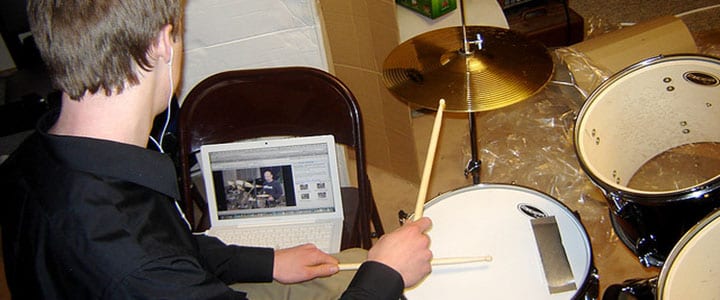As you advance in your drum lessons, you will want to take on more complicated drum patterns and grooves. Here, Federal Way, WA drum instructor Kendra M. explains how you can learn to play complex drum patterns…
There are many different ways to play complex drum patterns.
In this blog post, we will discuss three different ways to play complex drum patterns. We will also provide examples for each method so that you can hear how each one sounds.
What is a Typical Drum Pattern?
A drum pattern is typically a series of beats that are played in succession:
- The most common drum patterns are made up of four beats, which can be played with various combinations of kick drums, snare drums, and hi-hats.
- When playing a drum pattern, the goal is to create a sense of flow and keep the groove going.
- To do this, it is important to play the beats evenly and in time.
- Drum patterns can be simple or complex, depending on the style of music being played.
- In general, hip-hop and electronic music tend to use simpler patterns, while jazz and rock often utilize more complex patterns.
Regardless of the style of music, though, all drummers must be able to maintain a steady beat.
Ready to start mastering the drums? Sign up for online drum lessons and learn more, like what you see in the video below:
https://www.youtube.com/watch?v=LwKF7LiXW3I
3 Ways to Play Complex Drum Patterns – Your Official Drum Pattern Cheat Sheet!
As you advance in your drum lessons, you will want to take on more complicated drum patterns and grooves. Here, Federal Way, WA drum instructor Kendra M. explains how you can learn to play complex drum patterns…
Complex drum patterns can be intimidating for new drum students. Take this “tricky” groove for example:
Even though this groove sounds complex, there are actually several ways to break patterns like this one down into manageable parts. Before you know it, you’ll be able to play complex drum patterns with ease!
Using the example above, here are three ways to conquer difficult drum patterns:
Method 1: Simplify Each Line
Take out all of the 16th notes to play a simplified version of the pattern.
Then, add the 16th notes in, one limb at a time.
Method 2: Create Short Loops
Loop a short section of the pattern while keeping time on the ride cymbal.
Keep adding a little more of the pattern into the loop.
Method 3: Reduce the Number of Parts
Play the parts for only two limbs. For example: the right hand on ride cymbal and the left hand on snare.
Then, use a different set of two limbs. For example: the right foot on bass drum and the left hand on snare drum.
What is the Most Common Drum Pattern?
The most common drum pattern is the 4/4 time signature. This signature means that there are four beats in a measure, and each beat is equal to a quarter note. The 4/4 time signature is also known as common time, and it is used in a variety of genres including pop, rock, country, and jazz. Here are some more common drum patterns:
Hip Hop Drum Patterns
The hip hop genre has its roots in African American culture, and its drum patterns are reflective of this influence.
One of the most distinctive features of hip hop music is the use of the syncopated clave rhythm. This rhythm is often created by playing the snare drum on the off-beats, or the second and fourth beats in a four-beat measure. This creates a flowing, halftime feel that is perfect for dancing.
In addition to the clave rhythm, hip hop drums often make use of doubled up kick drums, or kicks that are played on both the downbeat and the upbeat. This gives the music a sense of forward momentum and energy. By combining these various rhythms, hip hop producers are able to create dynamic and engaging drum patterns that are perfect for gettin’ down on the dance floor.
House Drum Patterns
One of the most essential elements of house music is the drum pattern. The drum pattern provides the foundation for the track, and it can have a major impact on the overall feel of the song. There are a few different elements that need to be considered when creating a drum pattern for a house track.
First, the kick drum should be placed on every other beat. This will create a steady, four-on-the-floor rhythm that is perfect for dancing. Next, the hi-hats should be placed on the off-beats, between the kick drums. This will add some movement and interest to the pattern.
Finally, the snare should be placed on the two and four beats, providing a backbeat for the track.
By following these simple guidelines, you can create a solid foundation for your house track drumming patterns.
Jazz Drum Patterns
There are many different jazz drum patterns that can be used to create interesting rhythms and grooves.
One of the most basic patterns is a four-on-the-floor beat, which consists of four quarter notes played on the bass drum. This pattern can be varied by adding accents on the snare drum or cymbals, or by playing different strokes on the drums. For example, a four-stroke roll can be used to create a smooth, flowing sound, while a six-stroke roll gives the rhythm a more staccato feel.
Another common jazz drum pattern is the Charleston, which is created by playing two eighth notes on the snare followed by one eighth note on the bass drum. This pattern can be varied by changing the order of the drums, or by adding accents. Jazz drummers often use other percussion instruments such as cowbells or tambourines to add more color to their rhythms.
By experimenting with different patterns and rhythms, jazz drummers can create unique and exciting sounds that add to the overall texture of the music.
Drill Drum Patterns
Drill is a specific type of marching band percussion characterized by its very sharp, staccato sound. In a drill band, each musician typically carries a snare drum and a bass drum, and the ensemble also includes cymbals and other percussion instruments.
Drill bands are typically used in military and police ceremonial marches, but they can also be found in some high school marching bands.
Drum patterns in drill are usually very simple and repetitive, but they can be quite complex. The most basic patterns involve just two drums, but some bands may use three or more drums to create a more full sound.
Drill bands often use a system of cues to signal changes in the music, and the drummer may have to keep track of several different cue lines simultaneously. Though it may seem like a simple task, playing drill requires a great deal of precision and coordination.
Rock Drum Patterns
Rock music is built on a foundation of strong rhythms. The drums provide the pulse that drives the song forward, and the other instruments lay down layers of rhythm on top of that. As a result, creating interesting and original drum patterns is essential for any rock band. There are a few basic elements that all good rock drum patterns have in common.
First, they should be catchy and easy to remember.
Second, they should have a strong backbeat that gives the song energy and drive. Third, they should be varied enough to keep the listener engaged.
And finally, they should be played with precision and power. With these elements in mind, any drummer can create rock drum patterns that will make their music sound great.
Be Patient When Learning Advanced or Basic Drum Patterns
If a groove is too difficult to play all at once, break it up. Keep building the groove from the most basic version you can create, to its complete form, step by step.
The more familiar you become with each element of the groove, the closer you will come to putting it all together. Don’t worry about speed at first; practice each variation at a tempo where you can play it successfully.
Be patient. Think of each challenging groove as a puzzle created for your enjoyment. Then, piece it together and have fun!
Want to improve your drumming skills? Sign up for lessons with a private drum instructor!
 Post Author: Kendra M.
Post Author: Kendra M.Kendra M. teaches drum lessons in Federal Way, WA. She has performed with professional orchestras across the United States and earned her Doctorate of Music from the University of Arizona. She is interested in the percussion music of cultures across the globe, and she has spent time studying drums abroad in Trinidad and Ghana! Learn more about Kendra here!
Photo by Kyle Sorkness
Maile Proctor









